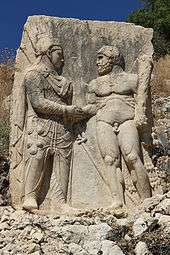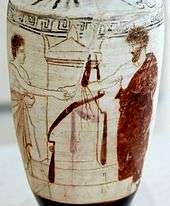Dexiosis


Dexiosis on Attic Lekythos 5th century BCE
Dexiosis (Greek δεξίωσις, dexiōsis, 'greeting' to δεξιόομαι, dexioomai ‚ ‘to give (someone) the right (hand)’ δεξιός, dexios ‘right’, Latin dextrarum iunctio ‚’joining together of the right hands’) is a term used in fine arts for the representation of two people offering each other their right hand.
The dexiosis reliefs from Commagene are well known, in which the then ruler is shown shaking hands with gods. Dexiosis reliefs are also known from Roman gravestones, which show the deceased with their spouses [1] Similarly dexiosis reliefs are found on ancient coins, on which they are intended to show the bonds between two cities by shaking hands. Portrayals of dexiosis are also known from much earlier times when they appeared on vase paintings.
See also
References
- ↑ http://farms.byu.edu/publications/review/?vol=18&num=1&id=616 Stephen D. Ricks, Dexiosis and Dextrarum Iunctio: The Sacred Handclasp in the Classical and Early Christian World
Links
| Wikimedia Commons has media related to Handshakes in art. |
This article is issued from Wikipedia - version of the 2/13/2016. The text is available under the Creative Commons Attribution/Share Alike but additional terms may apply for the media files.